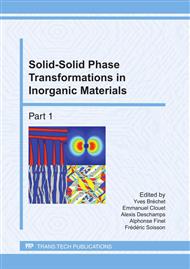p.1044
p.1050
p.1060
p.1066
p.1072
p.1078
p.1084
p.1090
p.1096
Phase-Field Modelling of Spinodal Decomposition during Ageing and Heating
Abstract:
Despite the tremendous success of phase-field (PF) modelling in predicting many of the experimentally observed microstructures in solids, additional progress is required in order to apply it to predict microstructure evolution in real alloy systems. One way to achieve this is to couple thermodynamic and kinetic databases with PF model. In this work, we present phase-field simulations of spinodal decomposition in Fe-Cr alloy during thermal ageing and anisothermal heating. In the PF method, the local free energy is directly constructed using the CALPHAD method. During isothermal ageing, the morphology of decomposed phases consisted in an interconnected irregular shape for short ageing times, and a further ageing caused the change to a droplet like shape of the decomposed Cr-rich phase. The influence of heating rate on phase transformations is then simulated and compared with experimental results obtained by differential thermal analysis, carried out with heating rates in the range 0.5 °C.min-1 to 15 °C.min-1. The simulation results show that heating rate strongly influences the microstructure morphology.
Info:
Periodical:
Pages:
1072-1077
Citation:
Online since:
June 2011
Authors:
Price:
Сopyright:
© 2011 Trans Tech Publications Ltd. All Rights Reserved
Share:
Citation:


